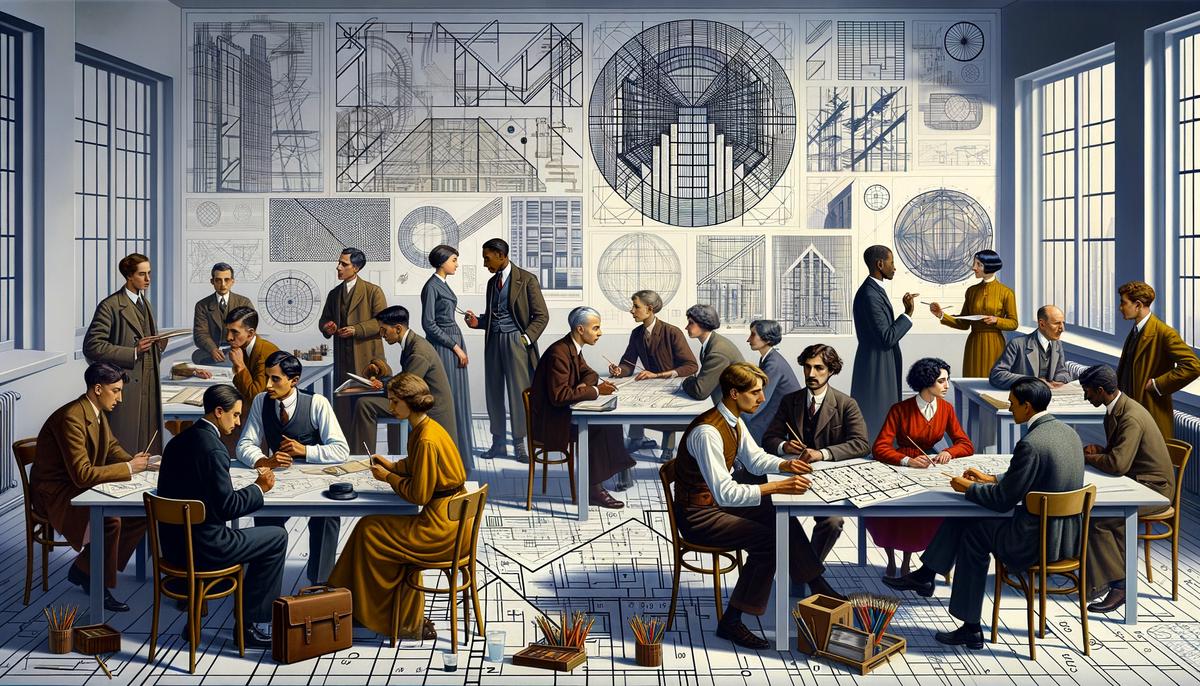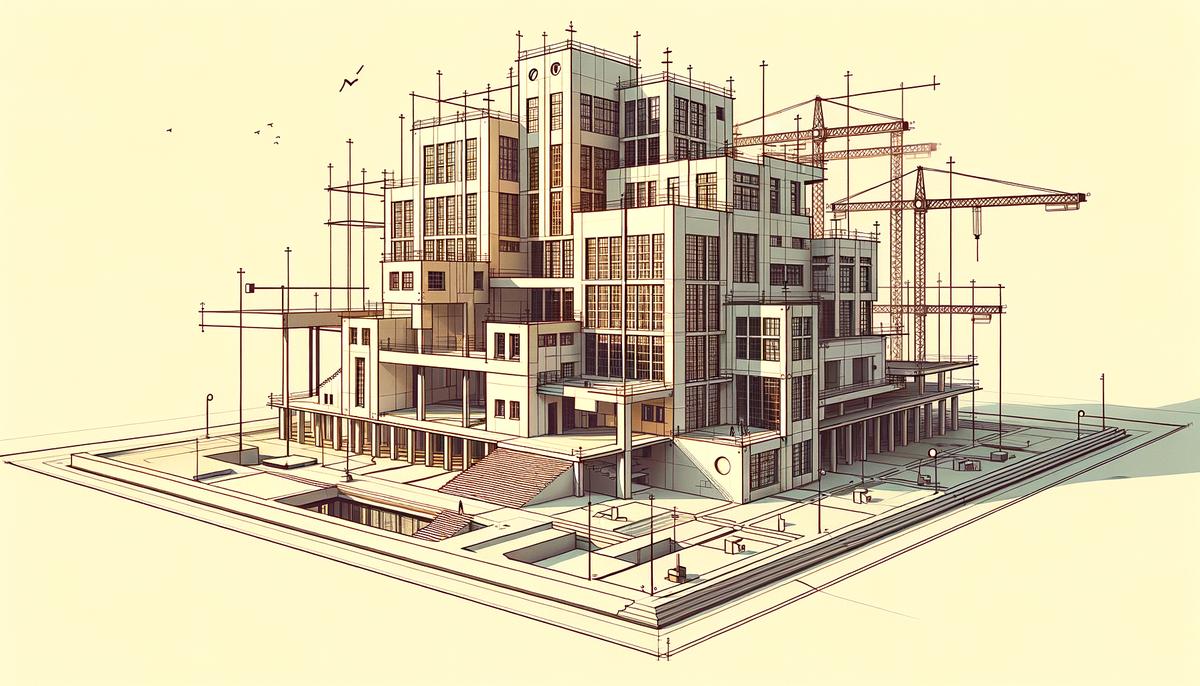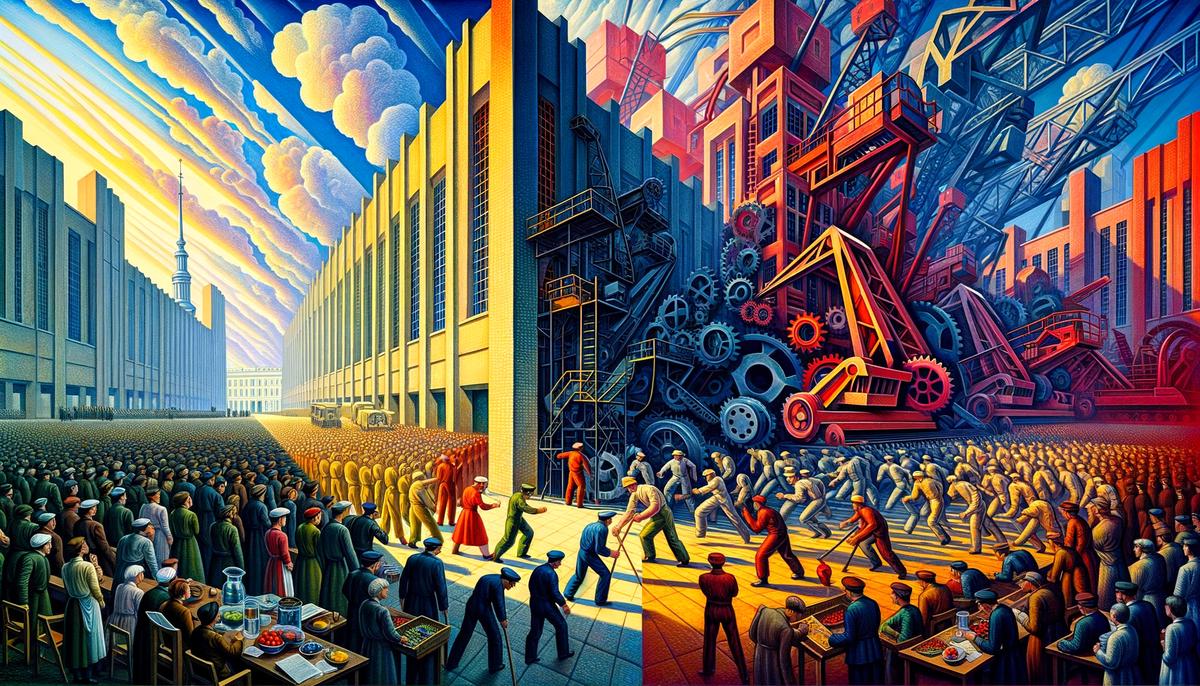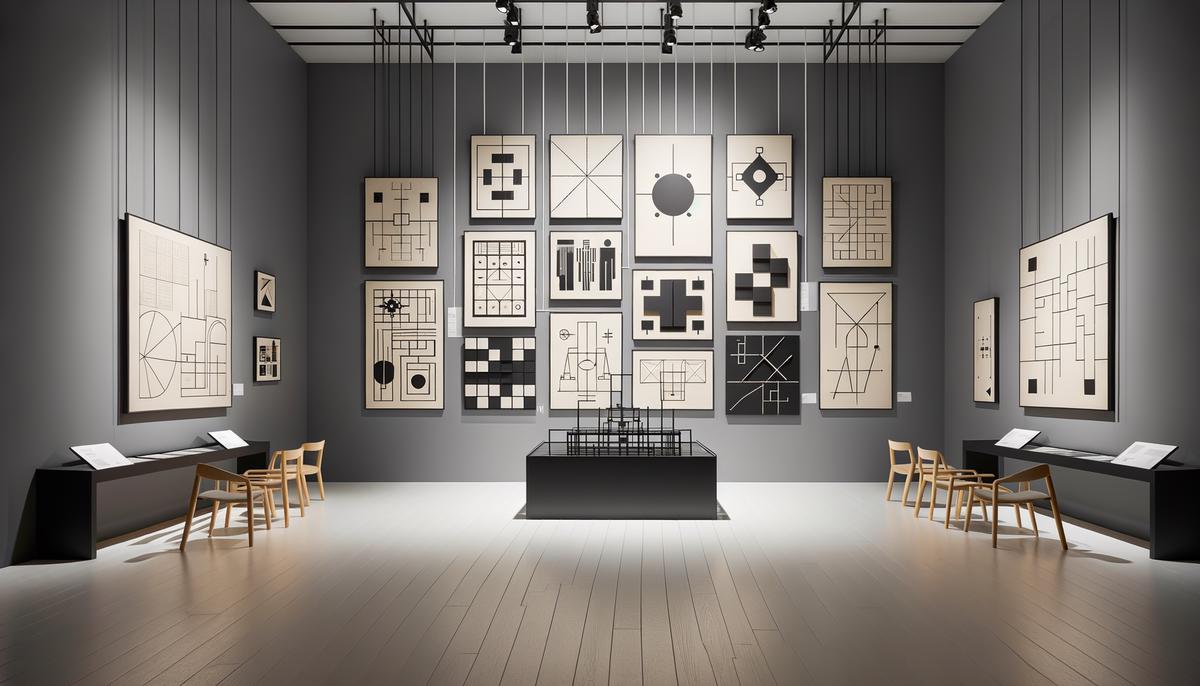Constructivism, a movement that emerged in early 20th-century Russia, demonstrates the significant role of art and architecture in shaping society. This article explores the journey of Constructivism, from its beginnings in a time of political and social upheaval to its lasting impact on modern art and architecture. Through this examination, we discuss the principles, influence, and eventual decline of this movement, highlighting its enduring legacy in contemporary creativity.
Origins
Constructivism developed in early 20th-century Russia, a time when the country was experiencing significant social and political change. The country had recently transitioned from a monarchy to the early stages of the Soviet Union. In this context, Constructivism emerged as artists and architects sought to reshape society through their work. The movement was driven by the belief that art was not merely for artistic expression but also a means to shape the new social order.
Vladimir Tatlin, a key figure in the development of Constructivism, found new artistic inspiration after visiting Picasso's studio in 1913. Influenced by Picasso's cubist constructions, Tatlin's work marked a shift from traditional artistic norms. His model for the Monument to the Third International exemplified this change. Although never built, the towering, spiraling structure represented the ambition to combine art with political and social ideals.
Other artists, such as Alexander Rodchenko, El Lissitzky, and their colleagues, soon rallied around this new artistic vision. They saw themselves not only as artists and architects but as contributors to the construction of a utopian society. Rodchenko and Stepanova applied this ethos across various fields, including photography, graphic design, and textile design, ensuring that every artistic endeavor served the collective.
El Lissitzky stands as another significant representative of Constructivism. With projects like the Proun series, he moved beyond traditional painting to create art that supported societal growth. He explored geometric forms and spatial configurations, aiming not only to create art but also to construct spaces that stimulated thought and action.
Constructivism extended beyond fine art, influencing everyday life. Textile designers Popova and Stepanova applied Constructivist principles through dynamic geometric patterns on fabric, making art accessible to the broader community.
Constructivism was fueled by a dialogue with international modernist movements. Lissitzky's exchange of ideas with the Bauhaus in Germany and exposure to avant-garde circles abroad demonstrates that Constructivism was part of a broader narrative of global artistic evolution.
The rise of Constructivism in Russia resulted from a combination of societal changes, passionate innovators, and a radical vision for art's role in the world. It exemplifies moments when people dare to imagine a future radically different from the known, driven by the belief that their creations can redefine the essence of life.

Principles
Core Principles of Constructivism: The Blueprint of a Movement
Examining the core principles of Constructivism reveals a movement built on ideology and a desire for change. The foundations of Constructivism were based on principles that combined art, industry, and community into an avant-garde approach, aiming to transform society.
Materiality: The Cornerstone of Constructivism
Materiality is a fundamental principle of Constructivism. Materials were carefully selected not only for their aesthetic qualities but also for their inherent properties and potential to contribute to functional design.1 This approach emphasized the practical application of art rather than mere aesthetic appreciation.
Construction: More than Just Building Blocks
Construction, another key principle, involves the assembly of materials in ways that align with functional purpose and innovation. Constructivist artists moved away from traditional painting and sculpture, instead focusing on projects like the Proun Room and designing textiles that reflected the dynamism of a changing society. The act of construction served as both a method and a metaphor, representing the transition from old orders to a new societal framework.
Integration of Art and Industrial Production: The Manifesto in Action
A notable aspect of Constructivism was its commitment to integrating art with industrial production. Constructivists envisioned a world where art was not confined to galleries but instead integrated into everyday objects, making it transformative and accessible.2 This integration promoted an ideology where every designed object, from propaganda posters to worker uniforms, served as a vehicle for change, combining aesthetic significance with practical utility.
These principles formed the foundation of Constructivism, supporting a movement that reshaped art and architecture to align with a vision of societal transformation. The principles worked together to create a coherent approach, where every element contributed to the goal of constructing a bold new world vision.
Exploring Constructivism's core principles reveals an architectural plan for a revolutionary spirit, where each principle builds upon the others to construct not just art or buildings, but a vision for a new society. This was not merely innovation on a canvas; it was a manifesto made tangible, driven by the belief that art has the power to reshape the world.

Impact
Impact of Constructivism on Art and Architecture: The Legacy that Shaped the Modern World
Constructivism left a significant mark on modern art and architecture, influencing not only its contemporaries but also shaping the course of modernist expressions. Its legacy continues to inspire architects and artists today.
The Revolution Architectured
Within Russia, Constructivism translated from concept to reality, infusing architecture with industrial aesthetics and functionalism. Buildings became manifestos of a new order. Shukhov's Radio Tower, with its innovative hyperboloid structure, exemplifies Constructivism's embrace of modern materials and technologies, achieving structural ingenuity without compromising beauty.
The Narkomfin Communal House went beyond being a simple apartment building; it embodied the principles of community living and social functionality. Its innovatively interconnected living spaces laid the groundwork for future explorations into sustainable architecture and urban design, influencing trends like 'microapartments' that we see today.3
Exporting the Revolution
Constructivism's influence extended beyond Russia, interacting with other avant-garde movements internationally. In Germany, Constructivism synergized with the Bauhaus principles of form following function and the embrace of industrial technologies. This cross-pollination influenced the designs and ethos of architects like Walter Gropius and Ludwig Mies van der Rohe, shaping the development of international style architecture.
Shadow and Substance
Constructivism's most enduring impact has been its influence on the ethos of modern art and architecture worldwide. Its principles can be seen in the sleek designs of contemporary skyscrapers, the simplicity of modern industrially-produced furniture, and the functionality of tech products. The idea that art should be integrated into life, combining usefulness with a message, continues to shape design thinking, education, and practice globally.
In the realm of art, Constructivism's impact is evident in the work of minimalists, who drew inspiration from its dedication to stripping art down to its essentials while retaining meaning and purpose. At its core, the movement encouraged artists and architects to question, rebel, and reimagine, fostering a deeper connection between art, society, and functionality.
Constructivism stands as a pivotal moment in the history of art and architecture, challenging traditional aesthetics and bridging the gap between art and utilitarian purpose. Its influence endures, shaping not only physical structures but also our understanding of space and design. As we navigate our modern world of sleek devices and open workspaces, we can trace the legacy of Constructivism's visionary spirit—a legacy that pioneered the integration of art and architecture in shaping the future.

Decline
Why Did Constructivism Decline in the Soviet Union? : Unraveling the Threads of its Downfall
Constructivism, once a vibrant force in Soviet art and architecture, gradually lost prominence, overshadowed by the rise of Socialist Realism. The decline of Constructivism was a gradual process, influenced by a combination of political changes, social transformations, and evolving artistic narratives. Let's explore the factors that contributed to the waning of Constructivism in the Soviet Union.
The Political Plot Twist: From Revolution to Regulation
The initial shift occurred with a change in political direction. In the early days of Soviet rule, Constructivism flourished as a symbol of the revolution, providing a visual language for a society in transformation. However, as the state sought stability and control, the tide began to turn.
The rise of Socialist Realism, officially endorsed by Joseph Stalin after 1934, emphasized the ideals of socialism over the experimental and abstract tendencies of Constructivism.4 Socialist Realism presented a narrative that glorified the proletariat and promoted optimism and ideological purity. This artistic direction left little room for the abstract explorations and industrial aesthetics of Constructivism.
Social Fabric: Weaving Uniformity Over Innovation
The social context of the Soviet Union in the 1930s and beyond favored representations of stability, unity, and progress that were more accessible than Constructivism's avant-garde ideas. Socialist Realism provided a comforting narrative, depicting a world free from class struggle and capitalist influences—narratives that resonated with the masses seeking stability in a turbulent Soviet landscape.
As society moved towards a uniform ideology, art that deviated from celebrating party values and proletarian heroism found itself marginalized. The Constructivist vision of a societal utopia shaped by avant-garde art and architecture seemed increasingly disconnected from the reality of living under an authoritarian regime.
The Artistic Exodus: The Call of the West
Some of Constructivism's leading figures found their creative freedom limited by the Soviet embrace of Socialist Realism. Seeking broader opportunities and less restricted environments, many artists and architects emigrated to the West.
The West offered not only creative freedom but also recognition and appreciation for innovative ideas. This migration of talent left a void in the Soviet art scene, further diminishing Constructivism's presence and influence. Artists like Lissitzky and architects like Melnikov, whose visions once aligned with the promise of a new societal construct, became less celebrated in their homeland.
Curtain Call: The Legacy Lives On, Despite the Decline
The story of Constructivism in the Soviet Union may seem like a tale of a promising movement overshadowed by political dogmas and social demands for conformity. However, despite its decline under the Soviet regime, Constructivism's legacy endured, influencing modern designs and architectural aesthetics worldwide.
Constructivism continues to captivate future generations with its utopian idealism and commitment to functional beauty, demonstrating that even when movements decline within specific contexts, true innovation transcends boundaries.
The decline of Constructivism in the Soviet Union was a complex process shaped by political maneuvering, social transformations, and artistic migrations. It highlights the tension between creativity and conformity and serves as a reminder that even in decline, great ideas lay the foundations for future innovations.

Legacy
In the history of artistic movements, Constructivism's departure from the Soviet stage marked a significant shift. Discredited and displaced by the rigid decrees of Socialist Realism, Constructivism's influence could have faded into obscurity. Yet, in the realms of contemporary art and modern cities, the legacy of Constructivism persists, influencing contemporary creations.
Artistic Ancestry Unveiled: Contemporary Art's Constructivist DNA
In avant-garde galleries, minimalist art installations, and digital art exhibits, the influence of Constructivism is evident. Constructivism's philosophy—a fusion of art with everyday life, where functionality enhances beauty—resonates in contemporary works1. Today's artists, using both traditional and digital tools, embody Constructivism's spirit by merging aesthetics with commentary on social structures, technology, and the relationship between humans and their environment. Beyond mere artistic style, it's a belief in art's role as an agent of change and functional interaction with society.
Skyward Bound: Constructivism and the Living Breathers of Steel and Glass
Modern architectural structures stand as testaments to Constructivism's enduring aesthetics. These buildings, whether skyscrapers or residential spaces, carry in their framework the legacy of Constructivism's principles: functional beauty, material authenticity, and design that reflects its era2. From towering skyscrapers to residential buildings echoing the communal aspirations of the Narkomfin building, modern architecture acknowledges its Constructivist roots, demonstrating the ongoing relevance of past prototypes.
Material Matters: The Constructivist Palette in Modern Design
In product design, Constructivism's influence is reimagined. In our digital age, where simplicity and functionality are key, Constructivism's principles are applied with a modern twist. Design philosophies emphasizing minimalism, user-centric functionality, and the harmonious integration of form and purpose—evident in sleek smartphones and ergonomic contemporary furniture—reflect Constructivist ideals3. It's through these tangible interactions that Constructivism's legacy is most intimately experienced by people.
Global Stages: Constructivism's Worldwide Whisper
Despite being sidelined within its birthplace, Constructivism fostered global dialogues that transcended geographical and temporal boundaries. From influencing the Bauhaus's functional purity to inspiring discussions around sustainable urban planning and modular construction worldwide, Constructivism's architectural principles endure. In educational settings where art and architecture are studied, Constructivism's concepts shape curricula, inspiring minds to innovate within and beyond established norms.
- Influencing the Bauhaus's functional purity
- Prompting discussions around sustainable urban planning
- Encouraging modular construction worldwide
The Ongoing Overture: Constructivism in the Conductor's Seat
Constructivism's legacy today is an evolving overture, adaptable yet recognizable in the landscape of modern art and architectural innovation. It's a philosophical undercurrent that runs through contemporary creation, surfacing where thought meets action in design. In an age marked by rapid transformation and interdisciplinary dialogue, Constructivism's synthesis of artistry and utility resonates significantly.

The decline of Constructivism in its homeland did not obscure its enduring legacy. Today, its principles—abstract yet deeply connected to life—continue to shape the visions of artists and architects. Far from being forgotten, Constructivism's spirit thrives in today's creative spaces, demonstrating that some influences, despite challenges, never truly disappear.
























